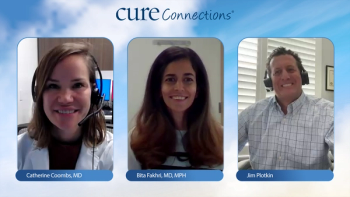
Tissue and Liquid Biopsies in NSCLC
The difference between tissue and liquid biopsies used in non-small cell lung cancer, and what patients should know about their results and treatment decision-making.
Episodes in this series

Hossein Borghaei, DO, MS: How do you explain the difference between what tumor testing and liquid testing are? How do you go about emphasizing why you want to do both?
Charu Aggarwal, M.D., MPH: This routinely comes up in my clinic, Hoss. I’m sure this is the case for you as well. I see a lot of patients who have been diagnosed outside of our center. We always request tissue samples to be sent to us for slide review to confirm the diagnosis of cancer. We also use that tissue sample to do some of the genotyping and genomic testing. But I always find that there’s a significant delay, especially if a tissue diagnosis has been made on the outside. For example, if a patient has seen me on a Monday, I sometimes might not even get their tissue slides until Wednesday or Thursday of that week. That’s already adding three or four days. Then my pathologist may say the sample is not enough. That notification may come the following Monday. So we’re already a week in, not knowing anything about the patient’s sample.
The way I describe it to my patients is that we now have two ways to test for genomic biomarkers. We can use tissue, which is still our gold standard, while recognizing that there may be delays or instances, like you pointed out, where it may not be enough sample. We’d like to take the opportunity to draw two tubes of blood while they’re in the clinic. The way I explain it is I say, “Tumors are shedding DNA into the bloodstream almost all the time. With this technology, we capture microscopic pieces of DNA, amplify it, and then sequence them to learn more about the tumor.” I also put in a plug right then and say there can be false negatives. There can be instances where the overall circulating tumor burden is not high enough that we’ll be able to detect it. Or it may be below the level of our detection. I also tell them, “Yes, we’re doing a liquid biopsy, but if it comes back with nothing detectable, it’s possible that we may still be in a situation where we’re waiting for the tissue testing.”
I also talk to them about the possibility of rebiopsying because it’s so essential to ensure that we have a complete biomarker panel. This isn’t just important for our first-line patients anymore. Now I have patients who were initiated on therapy two or three years ago and are now experiencing progression. With the recent approval of a drug targeting KRAS, I find myself going back and looking at the molecular profile of my patients and making sure I’m able to prescribe sotorasib or enroll them onto a KRAS trial if indicated.
There are lots of advantages that blood biopsies offer. They are minimally invasive and they’re fast. But we also have to keep our eyes open and understand that there may be situations where we don’t get the full answer.
Transcript edited for clarity.


